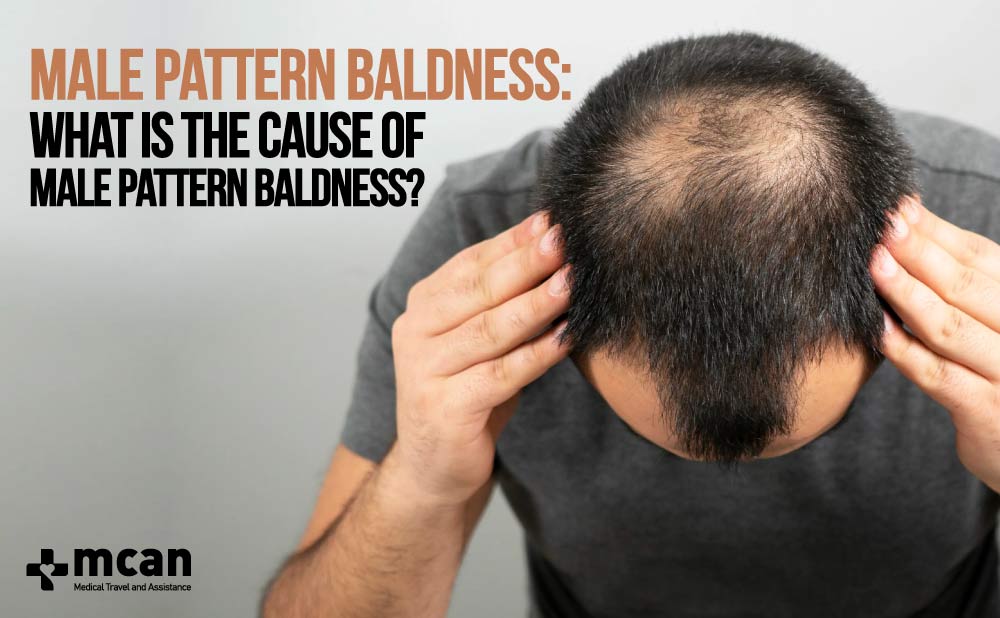
Male pattern baldness, also known as androgenetic alopecia, is progressive receding front hairline or loss of hair on the crown area (vertex), which approximately 50% of males worldwide encounter before age 50. As men grow older, around 70% of them will experience some degree of hair loss. Moreover, a quarter of bald men notice the initial indications of hair loss before turning 21. Male or female pattern baldness is originated from genetics. So, it is hereditary, which means it can be passed down from parents to their children.
What causes male pattern baldness?
Several factors influence male pattern baldness. Here are some of the key factors that contribute to the development and progression of male pattern baldness:
Genetic Predisposition: The primary factor in male pattern baldness is genetic inheritance. Having a family history of baldness increases the likelihood of experiencing hair loss. Specific genes inherited from both parents make individuals more susceptible to the effects of hormones on hair follicles.
Hormonal Factors: Hormones, particularly dihydrotestosterone (DHT), play a significant role in male pattern baldness. DHT is derived from testosterone and can bind to hair follicles, leading to their miniaturization and eventual cessation of hair production.
Age: Hair loss commonly occurs with aging. As men grow older, the likelihood of experiencing male pattern baldness increases. This is due to hormonal changes and the gradual weakening of hair follicles over time.
Androgen Sensitivity: Some individuals have hair follicles more sensitive to androgens (such as DHT). When androgens interact with these sensitive follicles, it can trigger the process of miniaturization, leading to hair thinning and loss.
Male Pattern Baldness Symptoms
Male pattern baldness, or androgenetic alopecia, typically follows a distinct pattern of hair loss. The most common symptoms and patterns associated with male pattern baldness include:
Receding Hairline: One of the initial signs of male pattern baldness is a receding hairline. The hairline gradually moves backward, often forming an “M” shape or a widow’s peak. The preferred hair restoration method for receding hairline is a DHI hair transplant.
Thinning Crown: As male pattern baldness progresses, hair loss may occur at the crown (top) of the head which leads to thinning or a bald spot, gradually expanding over time.
Hair Loss on the Temple Area: Hair loss can also affect the temples, forming a triangular-shaped bald patch on both sides of the forehead.
Hair Thinning: Besides hair loss, male pattern baldness often causes hair to become thinner, finer, and less dense, especially in the affected areas. This can make the scalp more visible.
Progressive Nature: Male pattern baldness tends to be progressive, meaning it worsens gradually over time. The rate and extent of hair loss can vary from person to person.
Normal Hairline on the Sides and Back: Unlike other forms of hair loss, male pattern baldness typically spares the sides and back of the head. These areas are usually unaffected or minimally affected by hair loss, contrasting with the thinning or balding areas on the top.
When Does Male Pattern Baldness Start?
Male pattern baldness, or androgenetic alopecia, can start at different ages for different individuals. However, it is most commonly observed to begin in adulthood. The Norwood-Hamilton scale highlights various stages of hair loss development and is the most widely used categorization system for male pattern baldness. The phases are as follows:
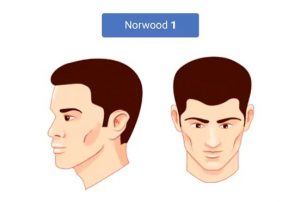
stage 1
Stage 1: Nothing to worry about if you are in Norwood Hamilton Scale stage 1. Stage 1, often known as the control stage, does not show any indications of hair regrowth. The only recessions on your temporal sides are slight ones.
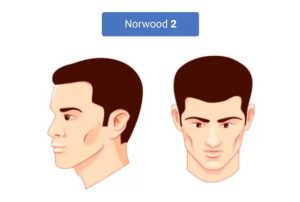
Stage 2
Stage 2: In stage 2, hair thinning may be hardly noticeable and tends to affect your temporal regions. You are likely at stage 2 if you feel that your temporal areas are receding and that your hair is becoming sparser.
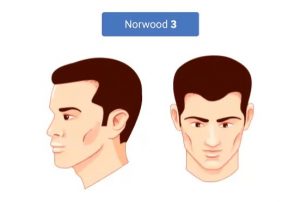
stage 3
Stage 3: Stage 3 is the first recession stage, which is extremely noticeable at the temples. Thus, around Stage 3, hair loss becomes apparent. At this stage, your hairline moves away from your temples and takes on an “M” shape.
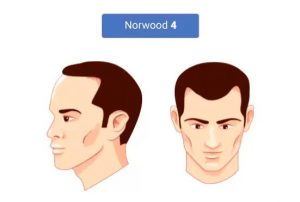
stage 4
Stage 4: In this stage, the recession of the hairline is more extreme. Due to more severe recession, you may have thin or no hair on your crown area, and your front hair forms a “U” shape.
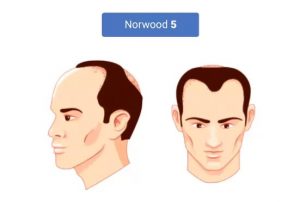
stage 5
Stage 5: The hairline is more severely receding at this stage. Your front hair may form a “U” shape, and you may have little or no hair on your crown area due to more severe recession.
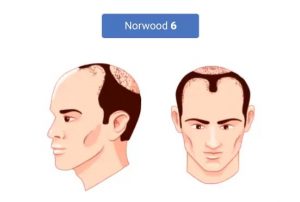
stage 6
Stage 6: The contrast between the front and the crown has almost completely vanished by the sixth stage of hair loss. There may still be hair on the sides of the head. However, most of the hair is lost, and the remaining hair looks to be dispersing on both sides.
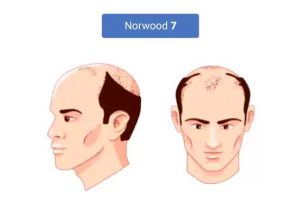
stage 7
Stage 7: The severity of baldness reaches an excessive and severe level by stage 7, the final stage of hair loss. Hair loss badly harms the side of the head and leaves the ears and neck hairless. The hair that does develop will probably be brittle and thin.
Cure for Male Pattern Baldness
Male pattern baldness or androgenetic alopecia is a dreadful experience most males and females suffer from. Fortunately, to prevent or stop hair loss, various treatments exist:
Medications: FDA-approved medications like minoxidil and finasteride are commonly prescribed for hair loss treatment. Minoxidil is a topical solution applied to the scalp, while finasteride is an oral medication. These medications work by either stimulating hair growth or preventing further hair loss.
Hair Transplant Surgery: Hair transplant surgery is popular for individuals with significant hair loss. It involves removing hair follicles from donor areas (typically the back or sides of the head) and implanting them into the balding or thinning areas. This procedure allows for natural hair regrowth and permanent results. The techniques are: FUE, Sapphire Hair Transplant, DHI and Needle-free Hair Transplant.
Low-Level Laser Therapy (LLLT): LLLT uses low-energy laser devices or combs to stimulate hair growth. The laser light penetrates the scalp and stimulates hair follicles, promoting regrowth.
Platelet-Rich Plasma (PRP) Therapy: PRP therapy involves extracting a patient’s blood, processing it to isolate platelet-rich plasma, and injecting the concentrated plasma into the scalp. The growth factors in PRP are believed to stimulate hair growth and improve the thickness and quality of existing hair.
Scalp Micropigmentation (SMP): SMP is a non-surgical cosmetic procedure that uses tattooing techniques to mimic the appearance of a shaved head or denser hair. It involves depositing pigments into the scalp to create the illusion of hair follicles.
 Mesotherapy for Hair: A Practical Treatment
Mesotherapy for Hair: A Practical Treatment  Have Concerns About Your Surgery Abroad? MCAN Health In House Nurse Is With You!
Have Concerns About Your Surgery Abroad? MCAN Health In House Nurse Is With You!  MCAN Health Announces Opening of New Office in London
MCAN Health Announces Opening of New Office in London